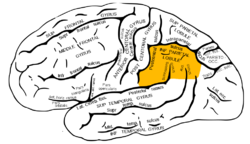Inferior parietal lobule
| Inferior parietal lobule | |
|---|---|

Lateral surface of left cerebral hemisphere, viewed from the side. (Inferior parietal lobule is shown in orange.)
|
|

Lateral surface of left cerebral hemisphere, viewed from above. (Inferior parietal lobule shown in orange.)
|
|
| Details | |
| Part of | Parietal lobe |
| Identifiers | |
| Latin | Lobulus parietalis inferior |
| NeuroNames | hier-89 |
| NeuroLex ID | inferior parietal lobule |
| TA | A14.1.09.125 |
| FMA | 77536 |
|
Anatomical terms of neuroanatomy
[]
|
|
The inferior parietal lobule (subparietal district) lies below the horizontal portion of the intraparietal sulcus, and behind the lower part of the postcentral sulcus. Also known as Geschwind’s territory after Norman Geschwind, an American neurologist, who in the early 1960s foresaw its importance.
It is divided from before backward into two gyri:
Inferior parietal lobule has been involved in the perception of emotions in facial stimuli, and interpretation of sensory information. The Inferior parietal lobule is concerned with language, mathematical operations, and body image, particularly the supramarginal gyrus and the angular gyrus.
Destruction to the inferior parietal lobule of the dominant hemisphere results in Gerstmann's syndrome: right-to-left confusion, finger agnosia, dysgraphia and dyslexia, dyscalculia, contralateral hemianopia, or lower quadrantanopia. Destruction to the inferior parietal lobule of the non-dominant hemisphere results in topographic memory loss, anosognosia, construction apraxia, dressing apraxia, contralateral sensory neglect, contralateral hemianopia, or lower quadrantanopia.
Functional imaging experiments suggest that the left anterior supramarginal gyrus (aSMG) of the human inferior parietal lobule exhibits an evolved specialization related to tool use. It is not currently known if this functional specialization is unique to humans as complementary experiments have only been performed with macaque monkeys and not apes. The habitual use of tools by chimpanzees makes the uniqueness of the human aSMG an open question as its function may have evolved prior to the split from our last common ancestor.
...
Wikipedia
